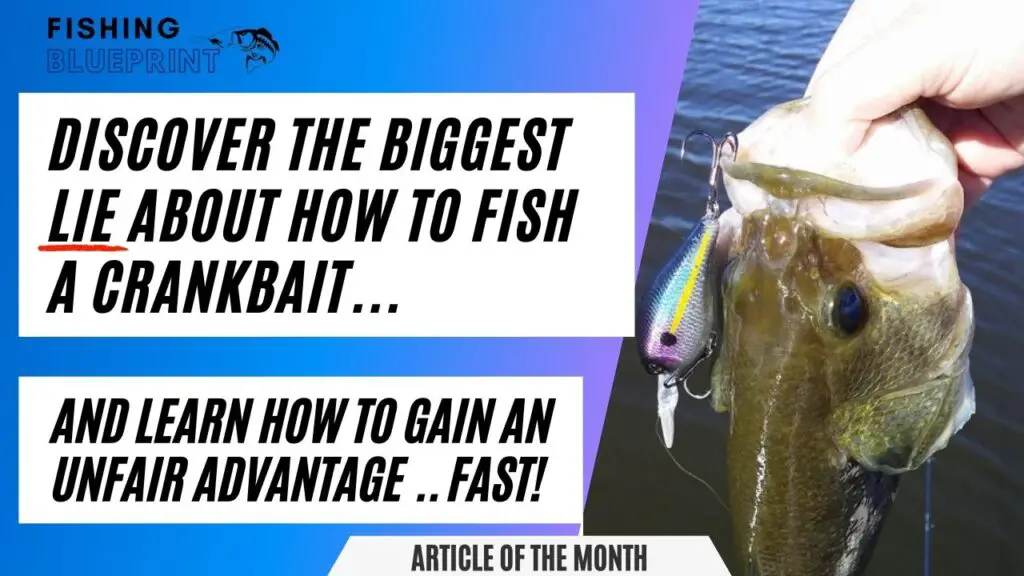How To Fish Lake McClure | Your Lake McClure Fishing Report

Lake McClure is a large lake that sits 145 miles away from San Francisco and 305 miles away from Los Angeles. It is located between Modesto, California and Yosemite National Park.
Overall it’s a popular lake, and sometimes fishing at Lake McClure can be absolutely amazing. But knowing how to fish Lake McClure can be very difficult. But luckily for you, in this post you’re going to be given the blueprint to fish this lake.
So what are the best tips for fishing Lake McClure? There are three important factors you must know if you want to know how to fish Lake McClure successfully. First, you need to know what kind of fish is in Lake McClure. Second, it’s important for you to know which part of the lake each species can be found. Lastly, knowing what are the best baits that work on Lake McClure is vital. However, tactics, baits, and locations will be different for each type of fish that you target. So let’s talk about the steps you need to take in order to give you the best chance of catching a fish on Lake McClure.
Key Takeaways
This lake gives locals and visitors the opportunity to test their luck in catching one of the many game species this lake has to offer, such as trout, bass, catfish, bluegill, and much, much more!
Here’s the most recent and updated Lake McClure Fishing Report – it gives you a quick and easy list of some really good fishing spots. If you’re looking for more detail on how to fish each spot scroll down into the article.
- New Exchequer Dam
- Wood Island
- Cotton Creek
- Temperance Creek
- Spillway Bay (also mention main point)
- Cemetery Ridge
- Arnold Bay
- Rei Man Bay
Here are some additional fast and helpful tips just for you:
- The easiest way to fish this lake is by boat, but there are areas to fish from the bank, or by kayak or float tube.
- There are public boat ramps to use.
- Camping and RV parking is available.
- You can buy tackle and groceries at the lake or at one of the tackle shops in Bakersfield.
About Lake McClure
Lake McClure is a deep body of water with a maximum depth of over 300 feet when the lake is completely full! The lake is approximately 9 miles long and 1 mile wide at main lake, however the river section is only 0.25 miles wide. It has over 80 miles of shoreline, and spans over 7000 acres. Lake McClure was first created in several stages between 1924 through 1926 by building the famous Exchequer Dam. The lake serves as home to a hydroelectric power plant and is vital for irrigation for local farming communities.
Important Lake Warnings
Algae blooms may be present which may affect fishing, swimming, and water contact in general.
According to parks.ca.gov, “every one of California’s new laws requires boat operators to have a California Boating Card. The card is required for anyone under the age of 41 to operate a boat in California’s waters.”
If you are fishing and camping, fire bans may be in effect due to the ongoing drought conditions.
What Kind Of Fish Are In Lake McClure
- Rainbow Trout
- Brown Trout
- Brook Trout
- Kokanee Salmon
- Largemouth Bass
- Smallmouth Bass
- Spotted Bass
- White and Black Crappie
- Bluegill and Sunfish
- Perch
- Catfish
Lake McClure Fishing Tips & General Strategies
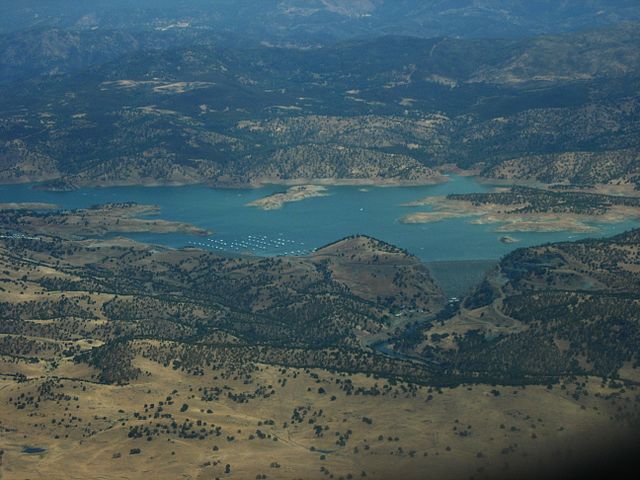
It can be a challenge to break down this body of water… So that’s why I created this Lake McClure Fishing Report to help you to easily start catching fish fast!
Water Clarity
Since this lake is vital for agriculture and drinking water collection the lake level often fluctuates.
The western side of the lake is known as the rocky side and is much deeper, and the eastern arm is more shallow and sandy with more vegetation and exposed brush.
Structures and Cover:
This is such a good place to fish because there are so many different kinds of fish to target and they all can live in different places on the lake. This means you’re not all crowded fishing in the same area! Here’s what to look forward to:
Rocky banks and boulders: The rocky terrain of the lake gives fish several places to hide and wait for their prey.
Points, drop-offs, and rock piles are all great places to check out.
Brush and Wood: The abundance of submerged wood and brush are great places for fish like bass and crappie to hide.
Weed Beds: Nearly all predator fish whether it’s a bass, crappie, or trout like living and hunting around vegetation.
Coves and Inlets: Lake McClure’s coves and inlets are great places to fish since they give fish a place to hide.
With frequent trout planting efforts, this lake gives anglers a massive opportunity to catch healthy trout.
As with most trout, during the summertime trout prefer the coolest water the lake can provide that is just above the thermocline. And in Lake McClure anglers commonly report the thermocline being approximately 30-45 feet deep.
Springtime Fishing update
When we sent out our recent email survey about how the lake was fishing this spring this is what we received back. During a typical spring at Lake McClure, the weather conditions were described by fellow anglers as generally pleasant and conducive to fishing. They reported the following weather patterns:
- Air Temperature: The temperatures experienced ranged from the mid-50s to low 80s (°F) during spring, with April and May being the warmer months. They recalled that mornings were cooler, gradually warming up as the day progressed.
- Wind Speed and Direction: The anglers mentioned that wind speeds were usually moderate, averaging around 5-15 mph. They noticed that the wind direction tended to be variable, but a prevailing westerly or northwesterly wind was common.
- Weather Patterns: The weather during spring was predominantly sunny and mild. However, they also experienced occasional rain showers and even some brief thunderstorms. They advised being prepared for sudden weather changes and keeping an eye on the forecast.
A fellow contributor (Tom G) helped all of us by sharing their experiences this spring. They also provided information about the water temperatures that trigger spawning for bass and where the trout can be found this spring.
Largemouth Bass:
- The angler reported that largemouth bass typically start spawning in late this spring, around April and May…when the water temperature reached 60-65°F
- They found that the most successful spots for targeting bass during the spawning season included shallow coves, submerged timber areas with gravel, and near weed beds.
- Some specific locations mentioned were: Cottonwood Cove, McClure Point, and Temperance Creek.
Another fellow angler shared their experience at Lake McClure this spring, specifically highlighting where trout and salmon could be found in the lake during this season.
Trout:
- The angler mentioned that during spring, trout could be found in various areas of Lake McClure. They reported that trout were particularly active in deeper, cooler waters as the temperatures started to rise. The easiest way to catch these silvery fish is to troll with a downrigger.
- Some of the spots he mentioned included the Merced River Arm, where the water remained colder, and the areas around Barrett Cove and Horseshoe Bend.
- Additionally, the angler noted that trolling in deeper waters with downriggers could yield promising results.
— I hope this report helps out guys. Tight lines!
Lake McClure – Summer Fishing update
The local chat boards have been talking about some effective baits and locations for catching trout and salmon at Lake McClure during the summer. This is what I’ve been able to put together:
Best Techniques:
- Trolling with downriggers in deeper waters, as trout and salmon seek cooler temperatures
- Using lead-core lines or weighted lures to reach the desired depth
- Casting and retrieving spoons or spinners in areas where fish are schooling
- Fly fishing trout from shore first thing in the morning.
- Powerbait or floating trout eggs from shore, casted out into deeper water from shore
Common Baits:
- Berkley PowerBait Floating Mice Tails
- Luhr-Jensen Kwikfish
- Rapala Original Floating Minnow
- Blue Fox Vibrax Spinners
- Mepps Aglia Spinners
- Berkley Powerbait
- Meal worms
Specific Locations:
- Merced River Arm
- Barrett Cove
- Horseshoe Bend
- Bagby Recreation Area
- McClure Point
Summer bass fishing update
A fellow angler shared their advice on the best techniques and baits for catching bass at Lake McClure during the summer, here’s what I summarized:
Best Techniques:
- Targeting structures such as weed beds, submerged timber, and rocky points had the best success.
- Fishing has been been in the early morning and late afternoon, when bass are more likely to be feeding
- Switching between both reaction and finesse techniques to trigger bites from aggressive bass and bass that are more reluctant to bite.
Common Reaction Baits:
- Strike King Red Eye Shad (Lipless Crankbait)
- River2Sea Whopper Plopper (Topwater Lure)
- Rapala DT Series (Diving Crankbait)
Common Finesse Baits:
- Yamamoto Senko (Soft Plastic Stickbait)
- Roboworm Straight Tail Worm (Drop Shot Rig)
- Zoom Brush Hog (Texas Rig)
Specific Locations:
- Cottonwood Cove – A popular spot on the weekends, has submerged timber and shallow coves that provide cover.
- McClure Point – Good rocky points that drops into deep water.
- Temperance Creek – A great location with weed beds and channels. Goog bass habitat.
- Barrett Cove – a productive bass cove with a shmorgishborg of fishing structures to target.
- Horseshoe Bend – A rocky banked spot. Good for smallies and spotted bass.
But Where Are The Best Places To Fish At Lake McClure?
And in no particular order here is that list of the best fishing spots at Lake McClure.
DISCLAIMER: The material provided is for general information purposes only. It’s important to understand that any information provided in this article can change at any time. Any maps or graphics featured are not to be used as navigational aids. Fishing Blueprint will not be responsible for any personal injury or property damage from any misuse of the maps or graphics provided. It’s completely impossible to give you every single spot where you can potentially catch a fish. But, what this list does do is to give you a helping hand and narrow down to the most productive fishing spots.
New Exchequer Dam
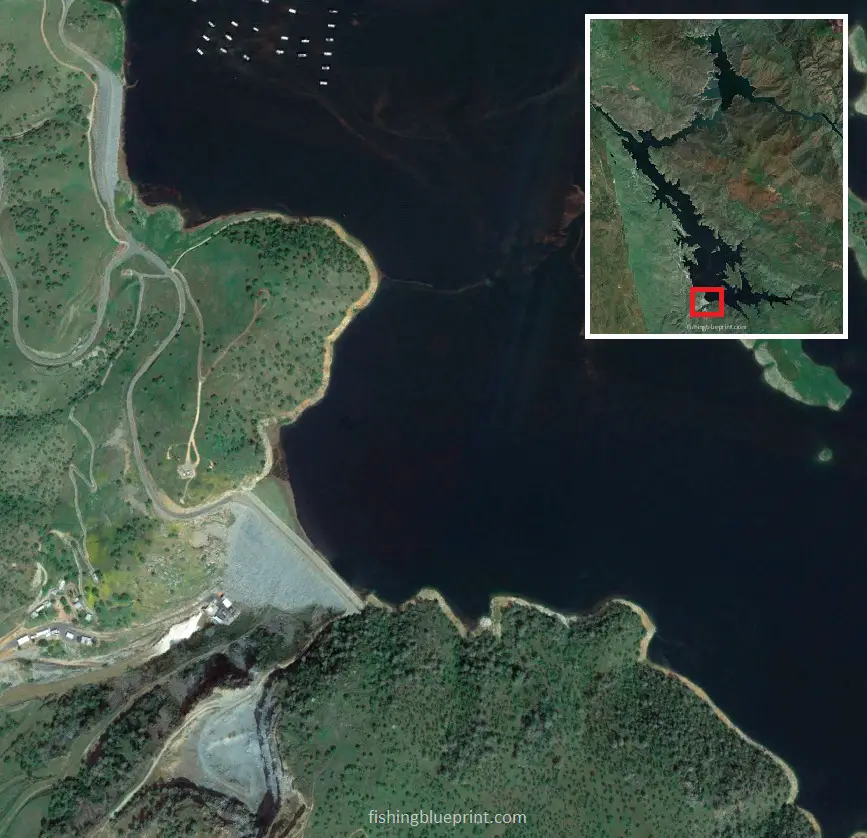
If you’re fishing for trout, the area between New Exchequer Dam and the end of Engineer Point can be great.
If the water level is low, you can find deep water humps that are rarely fished in the cove just west of the dam.
This part of the lake can have a lot of wind. Even if you have the best trolling motor, the wind can quickly blow you away from your spot, making it much harder to catch fish.
Because of this, we strongly advise you to buy a good drift sock. For people who don’t know, a drift sock is like a parachute for the water. If it’s breezy or windy, you need to slow your drift or your lure won’t be in the strike zone long enough to catch a fish.
Also, we found a great drift sock made by Mythik Outdoors, and the best part is that you can buy them on Amazon.com. You can learn more about drift socks and read reviews from real customers by clicking here.
Located: south lake
Structural features: steep rocky bank
Best species to target: trout
Most effective way to fish this spot: boat, kayak
Spillway Bay
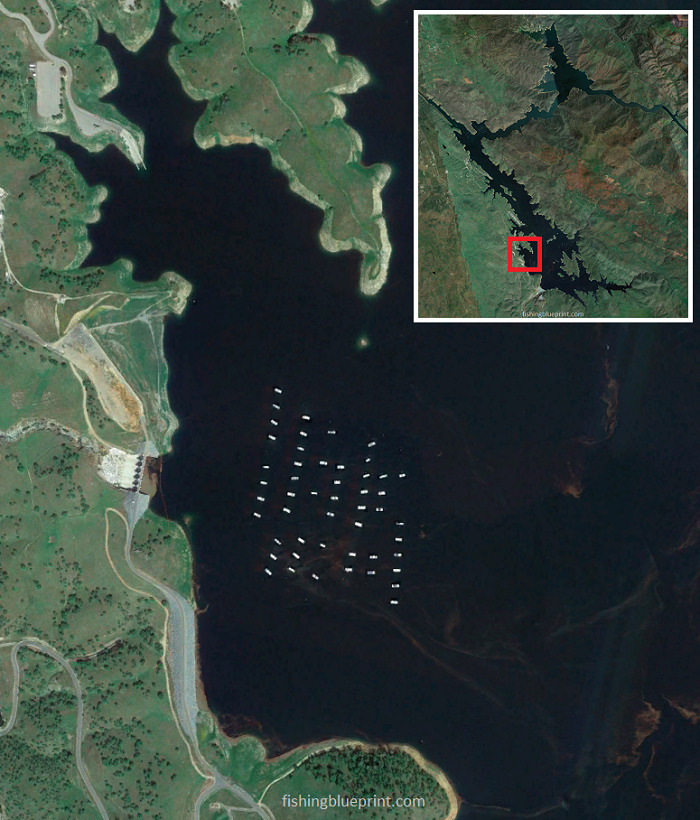
This section features a relatively large cove that has moderately tapered banks are lined with large chunk rock to boulder-size substrate, old road beds, intra-bay ledges, and a primary creek channel.
Naturally, crawfish, bluegill, minnows, and shad seek shelter in this area.
It’s best to focus your efforts on cuts, points, boulder piles, and transition areas from larger rock to smaller rock size.
The mouth of the bay and the main point is great for trout fishing.
In the back of the cove, largemouth and smallmouth bass as well as crappie will be caught here.
Look carefully at this spot with low water level…
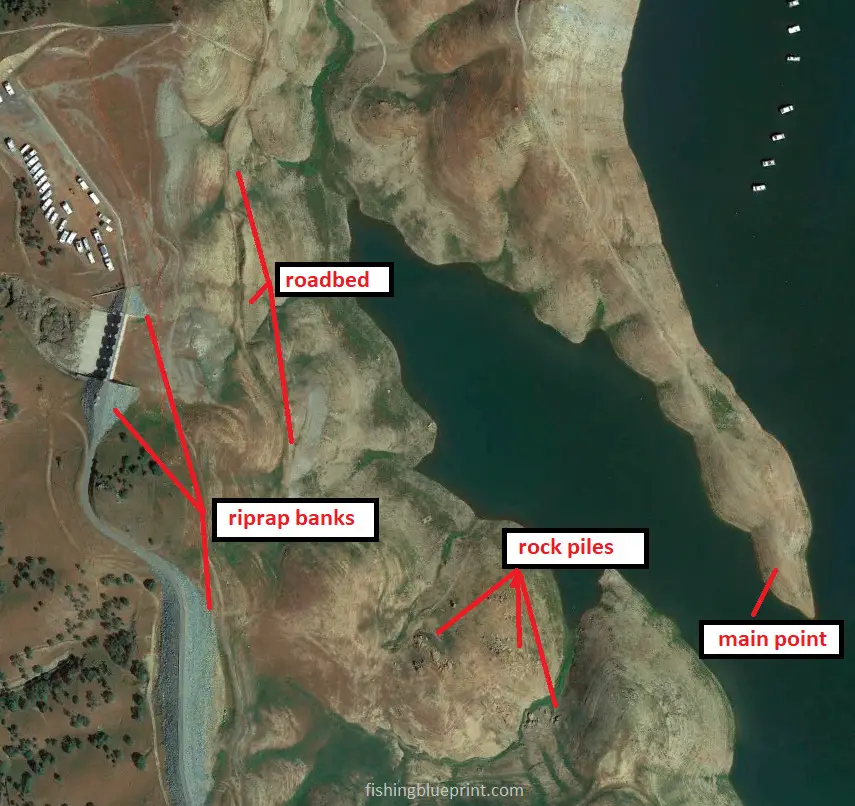
Located: south lake
Structural features: rock piles, road beds, ledges, creek channel.
Best species to target: trout, bass, crappie
Most effective way to fish this spot: boat, kayak, shoreline
Wood Island
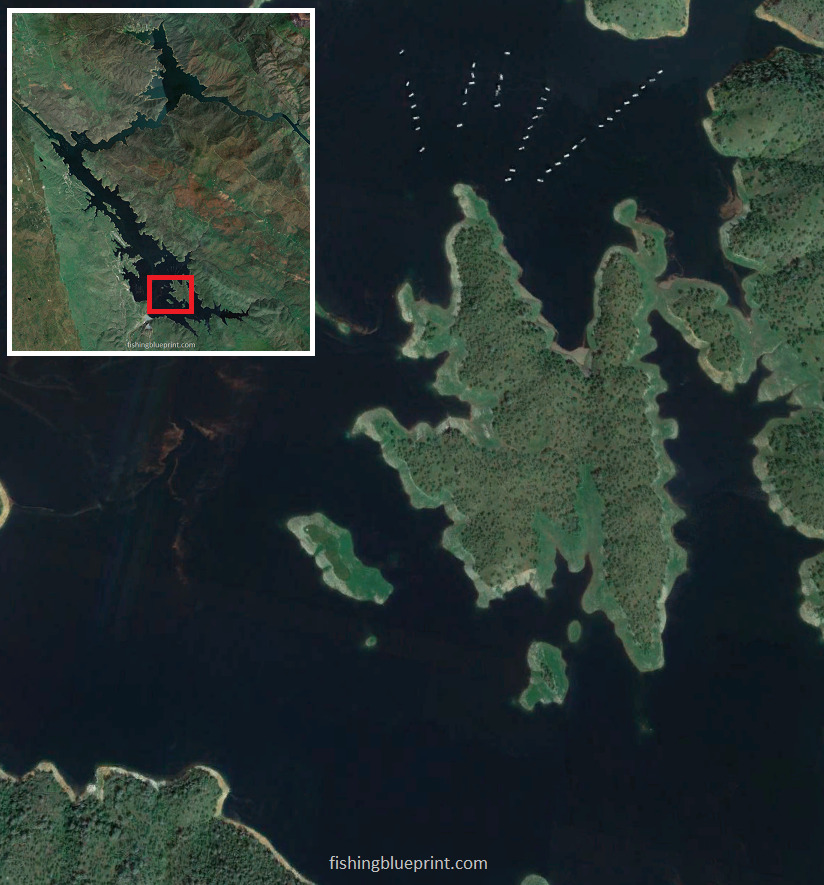
There are several long points on Wood Island that reach out into the main lake. Its banks are usually very steep and made up of big chunks of rock or boulders. It also has rises and falls.
You can catch trout, bass, crappie, pan fish, and catfish here.
The big rocks are a natural place for crawfish, bluegill, minnows, and shad to hide.
Since this is a big area, it’s best to focus on cuts, points, boulder piles, and areas where rocks change from big to small.
Located: middle section of the lake
Structural features: rocky banks, main lake points, humps, and drop offs
Best species to target: trout, largemouth bass, smallmouth bass, crappie, catfish
Most effective way to fish this spot: boat, kayak
Cotton Arm/Creek
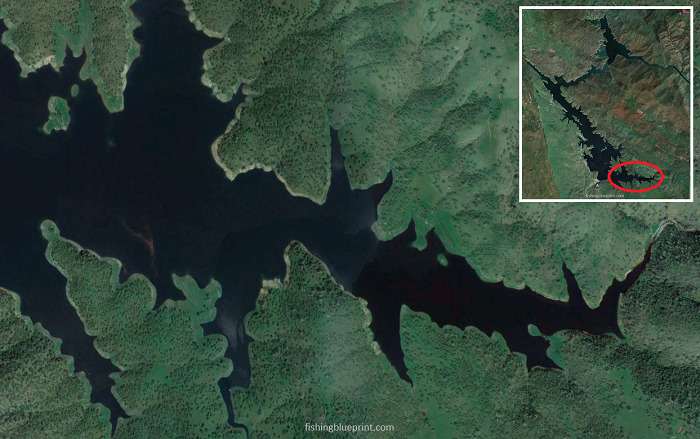
This long, straight cove has a deep channel that is fed by a number of small creeks.
One of the best things about this fishing spot is that there is one major creek channel that runs down the middle of it. Other ditches, which are smaller secondary creek channels, run into it like veins on a leaf.
There is a lot of underwater brush and a lot of tall trees in the channel, as well as underwater humps and sharp channel swings.
It’s a great place to fish for bass and crappie in the spring.
Trout are easy to catch at the mouth of the cove in late winter and early spring.
Catfish can be caught in the backs of bays with cutbait, chicken livers, hotdogs, or stinkbait that has already been made.
Small trout flies, dough balls, and Slim Jim bits are all things that can be used to catch sunfish and panfish.
Located: south lake
Structural features: deep water at the mouth, submerged and emergent vegetation, rocky structure, artificial structure
Best species to target: trout, largemouth bass, smallmouth bass, crappie, catfish
Most effective way to fish this spot: boat
Temperance Creek
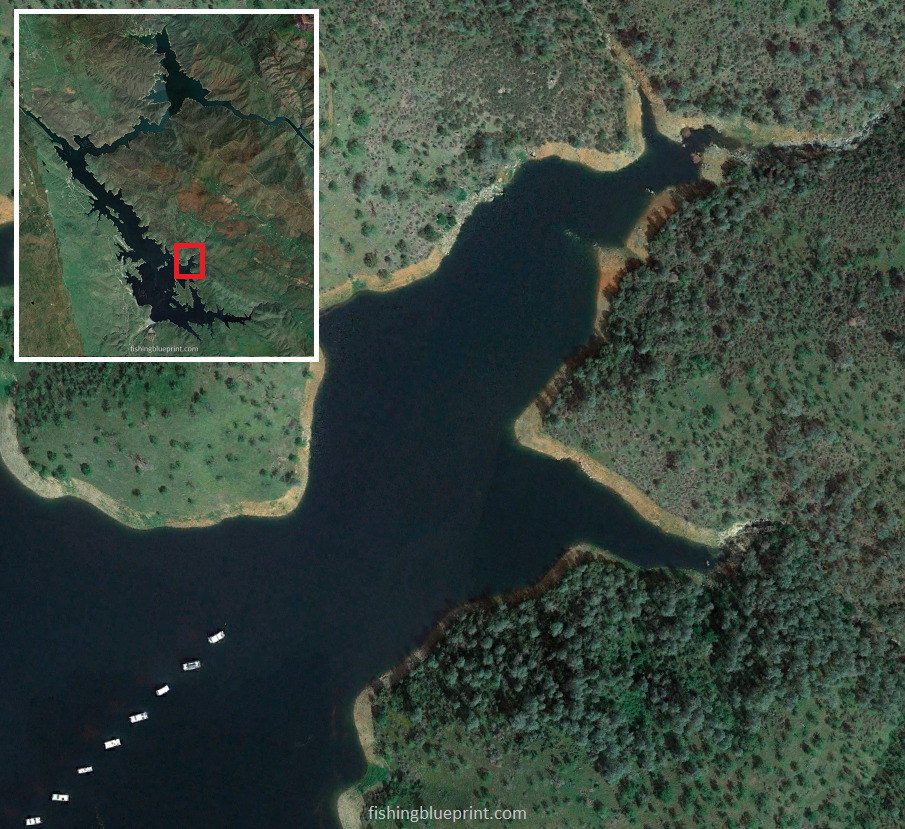
This cove leads into the lower lake. There are times when fishing here is very good. Some tournament fishermen like to brag that they can catch all the fish in an area in less than an hour.
At the end of the bay, there is some brush and wood that is underwater. Largemouth bass, smallmouth bass, bluegill, and crappie can sometimes be caught there.
Largemouth and crappie fish do well in the middle of the cove and at the mouth. This also has a deep waterway with many drops, rock piles, and boulders.
And it’s great for night fishing for catfish and crappie fishing under a green light.
Look carefully at this spot with low water level…
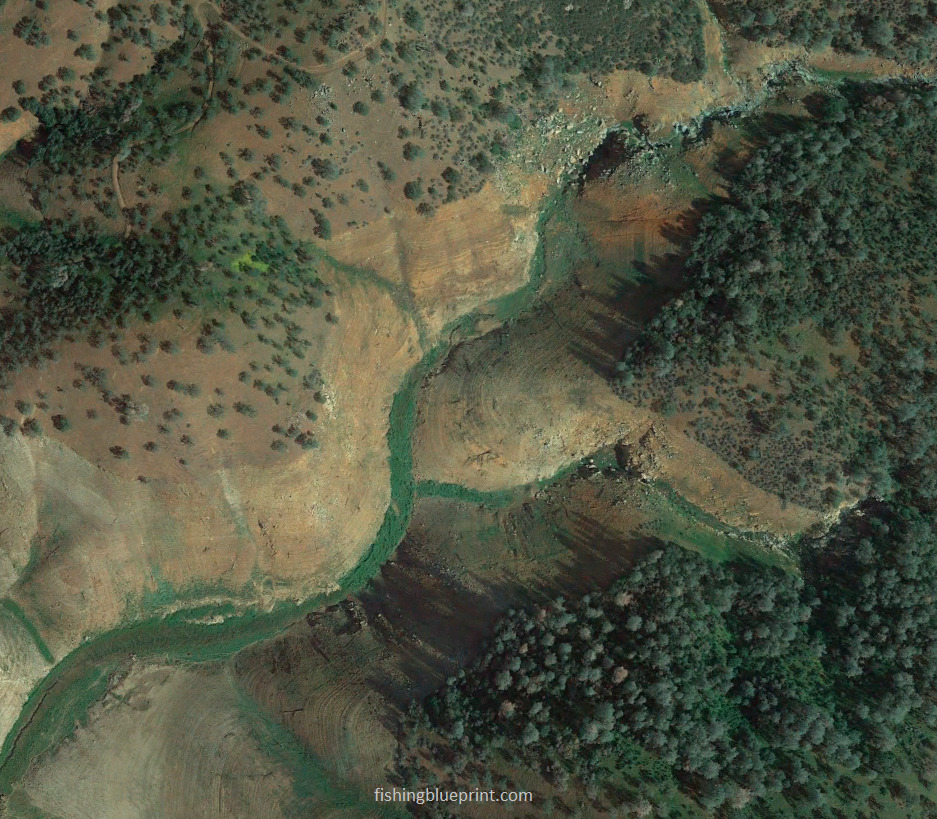
Located: southeast end of lake
Structural features: Submerged brush and timber, rocky points, channel swings, deep channel, drop offs.
Best species to target: Largemouth bass, smallmouth bass, catfish, bluegill, and crappie
Most effective way to fish these spots: Boat or kayak.
Cemetery Ridge

Cemetery Ridge is located upper part of the lower leg
One of its defining features is it is incredibly steep and drops into 100+ feet of water which makes this an excellent place to troll for cold-water fish like kokanee, and trout.
Smallmouth bass and spotted bass area also frequently caught here because of the steep rocky banks.
Look carefully at this spot using a topographic map…
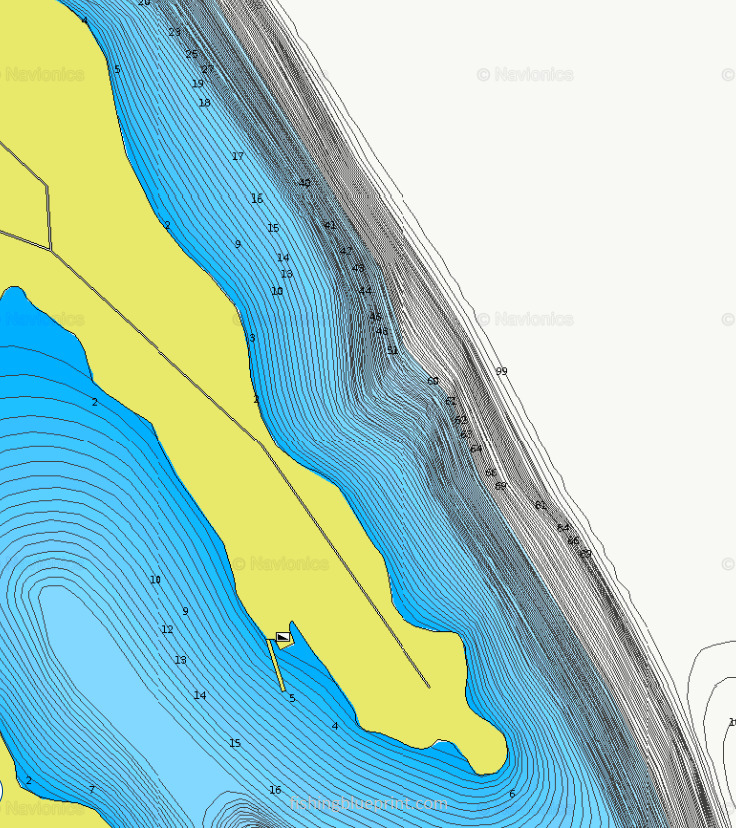
Given this embankment’s large area, it’s best to focus your efforts on cuts, points, boulder piles, and transition areas from larger rock to smaller rock size if you’re fishing for bass.
If you’re trolling for trout use your fish finder to mark the trout and stagger your lures 10-15 running depth separation.
You can also fish from the bank in this area.
Located: middle section of the lake
Structural features: long rocky bank
Best species to target: trout, largemouth bass, smallmouth bass, crappie, catfish
Most effective way to fish this spot: boat, kayak, float tube, shoreline
Arnold Bay

This spot is basically a big cove off an inside channel swing.
It gives anglers a lot of different places to fish, like multiple points, ledges, ridges, drop-offs, rock piles, and humps.
The best places to fish will be where any channels are close to another type of structure (like points, ledges, ridges, drop-offs, or humps) or close to some kind of cover.
This kind of place is great to fish in the spring and fall.
Before you try to fish everything, make sure you take some time to check thia areas with your fish finder to see if there are any bait fish or bass there. If there is bait, chances are that are bass in the area – that’s when you should fish it.
Look carefully at this spot with low water level…
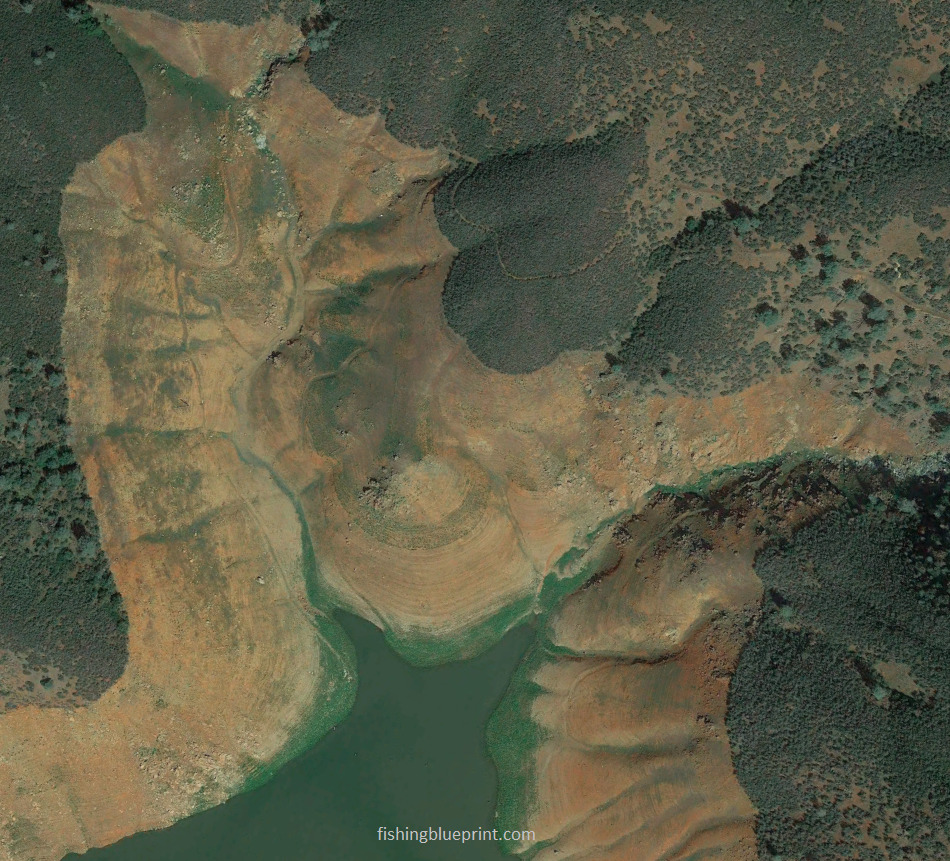
Located: upper section of the lake
Structural features: channel swing cove, points, hard structure
Best species to target: largemouth bass, smallmouth bass, spotted bass, crappie, catfish
Most effective way to fish this spot: boat
Rei Man Bay

This is a large open bay just off an inside swing of the main river channel of the lake.
It has many smaller creek ditches that drain into multiple larger creek channels, all of whom are submerged. This bay has many different structures you can target and fish.
The main creek channels that drain from the bay to the main lake create underwater main lake points. Scan these areas because they will often have rocky high spots, ridges, humps, and ledges associated with them.
Moving further into the bay, make sure to scan the ditch and channel interactions. This area also has rocky high spots, ridges, humps, and ledges, along with channel swings that can hold fish.
Look carefully at this spot with low water level…
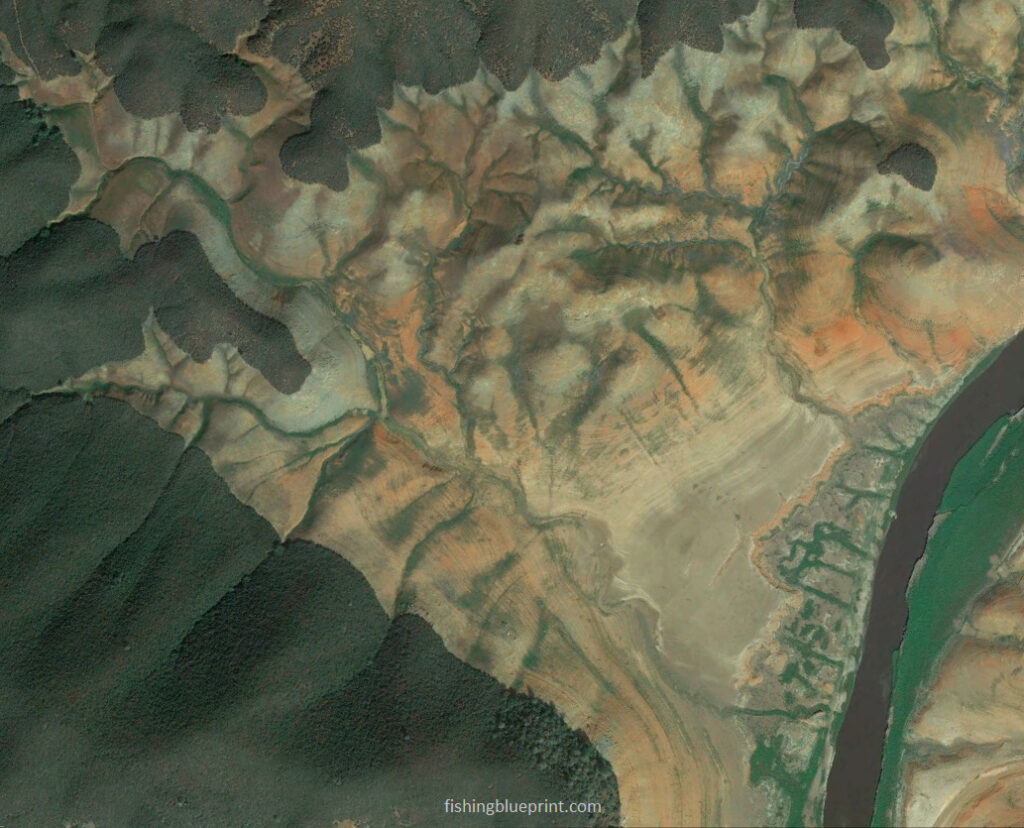
Located: upper section of the lake
Structural features: channel swing bay, points, hard structure.
Best species to target: largemouth bass, smallmouth bass, spotted bass, crappie, catfish
Most effective way to fish this spot: boat
Boat Ramps at Lake McClure
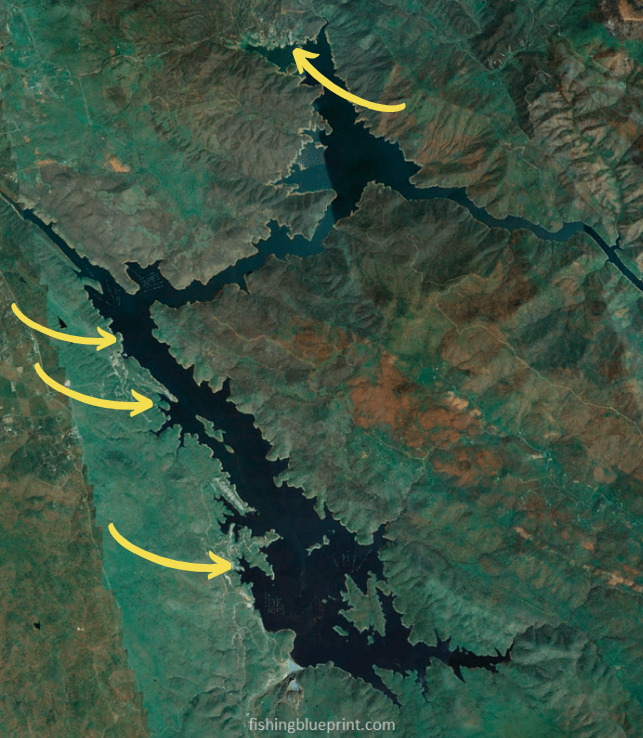
There are several boat launches at Lake McClure we listed them below…
McClure Point (Upper Launch)
Address: La Grange, CA 95329
Telephone number: not listed
Lanes: 2
Restrooms available: yes
Camping areas nearby: yes
Fish cleaning station: not listed
McClure Point (Lower Launch)
Address: La Grange, CA 95329
Telephone number: not listed
Lanes: 2
Restrooms available: yes
Camping areas nearby: yes
Fish cleaning station: not listed
Burnett Cove Boat Launch (south ramp)
Address: Unnamed Road, La Grange, CA 95329
Telephone number: not listed
Lanes: 2
Restrooms available: yes
Camping areas nearby: yes
Fish cleaning station: not listed
Burnett Cove Marina Boat Launch
Telephone number: not listed
Lanes: 2
Restrooms available: yes
Camping areas nearby: yes
Fish cleaning station: not listed
Horseshoe Bend Boat Launch
Address: 7278 CA-49, Mariposa, CA 95338
Telephone number: 1(209) 878-3452
Lanes: 2
Restrooms available: yes
Camping areas nearby: yes
Fish cleaning station: not listed
Bagby Boat Launch
Address: CA-49, Mariposa, CA 95338
Telephone number:
Lanes: 2
Restrooms available: yes
Camping areas nearby: yes
Fish cleaning station: not listed
Marinas at Lake McClure

Barret Cove Marina
Address: 3100 Barrett Cove Road,
La Grange, CA 95329
Telephone number: 209-378-2441
Open to the public or private: Open to the public
Boat Launch Available Lanes: 2
Gas available: yes
Restaurant/Store available: Yes, do they sell snacks, drinks, bait, frosty beverages
Boat rentals available: yes, fishing boats, ski boats, patio boats, houseboats, and personal watercraft
Restrooms available: yes
Camping areas nearby: yes
Fish cleaning station: not listed
Camping Near Lake McClure
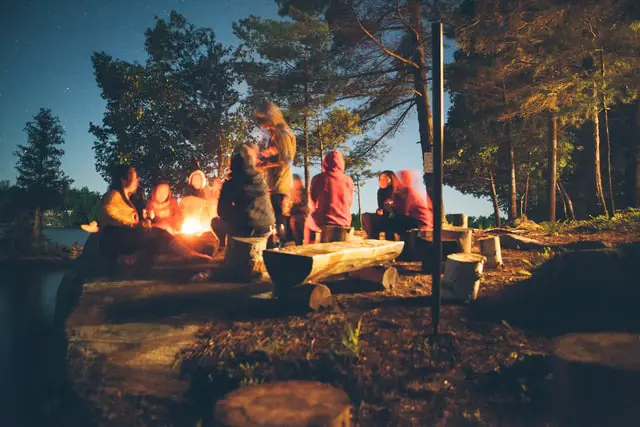
McClure Point Campground
Location: 9090 Lake McClure Rd, Snelling, CA 95369
Telephone number: (209) 354-2960
Sites: 100
- Tents, trailers, and small motorhomes are allowed
- Please read information on each individual spur size to determine if your RV will fit in the site.
Low season: October – March
High season: April – September
Concrete pads: yes
Fire ring: yes
Picnic table: yes
Showers: yes
Restrooms: yes
Nearby gas: yes
Pets welcome: yes
Nearby place to buy firewood: yes
Nearby place to buy groceries: yes
Campground map – click here
Reservations – click here
Barrett Cove Campground
Location: 3062 Barrett Cove Rd, La Grange, CA 95329
Telephone number: 1 (855) 800-2267
Sites: 249
- Tents, trailers, and small motorhomes are allowed
- Please read information on each individual spur size to determine if your RV will fit in the site.
Low season: October – March
High season: April – September
Concrete pads: yes
Fire ring: yes
Picnic table: yes
Showers: yes
Restrooms: yes
Nearby gas: yes
Pets welcome: yes
Nearby place to buy firewood: yes
Nearby place to buy groceries: yes
Campground map – click here
Reservations – click here
Horseshoe Bend Campground
Location: 4244 CA-132, Coulterville, CA 95311
Telephone number: (855) 800-2267
Sites: 97
- Tents, trailers, and small motorhomes are allowed
- Please read information on each individual spur size to determine if your RV will fit in the site.
Low season: October – March
High season: April – September
Concrete pads: yes
Fire ring: yes
Picnic table: yes
Showers: yes
Restrooms: yes
Nearby gas: yes
Pets welcome: yes
Nearby place to buy firewood: yes
Nearby place to buy groceries: yes
Campground map – click here
Reservations – click here
Bagby Campground
Location: 8324 CA-49, Mariposa, CA 95338
Telephone number: (855) 800-2267
Sites: 31
- Tents, trailers, and small motorhomes are allowed
- Please read information on each individual spur size to determine if your RV will fit in the site.
Low season: October – March
High season: April – September
Concrete pads: yes
Fire ring: yes
Picnic table: yes
Showers: yes
Restrooms: yes
Nearby gas: yes
Pets welcome: yes
Nearby place to buy firewood: yes
Nearby place to buy groceries: yes
Campground map – click here
Reservations – click here
In Summary...
As you now can see Lake McClure fishing can be tough at times, but it’s not impossible and with the help of the Lake McClure Fishing Report… It definitely helps you get started on the right foot quickly and easily, so you can avoid wasting hours wondering where and how to get started.
Did You Get All This?
As fellow fisherman and content creator I thrive on helping others… I feel like I can do the most good by helping others… And frankly… I would feel like I did something wrong if you didn’t walk away feeling a little better about this lake.
I truly want to over deliver for you…
So Let Me Ask You Another Question…
After reading this helpful report:
- Can you see how this could change the way you would fish this lake?… To make it easier, faster… and… with less headache, less frustration?
- If nothing else, do you now have a better sense of where you can get started, even if you have have been here?
- Do you feel that you have a good grasp of what species to expect in this lake?
- Do you have a good understanding what baits are needed to catch each of the different species of fish?
- Earlier we came up with some helpful spots to catch more fish, can you see yourself considering any one of those spots? Which ones are you the most excited about implementing when you get to the lake?
- Is it fair to say that using these spots would give you a significant advantage over someone else who’s fishing this lake?
I Need To Ask A Favor From You And It’s Not Going To Cost You A Single Dime…
If you have gotten anything out of this free report; whether its knowing where to get started, what kinds of fish are in Lake McClure , what baits to use, where to launch your boat, where to buy a frosty beverage, where to camp, and other things to do when you’re at this lake…
Then I need you to do something that is going to help your fellow angler…
And that is share this report. Please share it to as many people as you can. It’s free to you and it really helps me out as a creator.
Lastly… thank you for spending your time reading through this report and I hope you have a luck on the water.
THIS IS WHERE YOU CAN HELP ME THE MOST: There’s a lot of information about this subject you have found helpful, and I’m sure you’ll be able to put some of the knowledge bombs to use. But sharing this report helps drive traffic which in turn helps me at absolutely no cost to you. I love creating reports like this for you, and you like reading these types of reports please share this with your friends, family, and fellow anglers.
Click on your favorite social media buttons to share this page now!
Other California Related Fishing Articles
- Bass Lake Fishing Report
- Clear Lake Fishing Report
- Castaic Lake Fishing Report
- California Delta Fishing Report
- Diamond Valley Lake Fishing Report
- Don Pedro Reservoir Fishing Report
- Eagle Lake Fishing Report
- El Capitan Reservoir Fishing Report
- Lake Berryessa Fishing Report
- Big Bear Lake Fishing Report
- Folsom Lake Fishing Report
- Irvine Lake Fishing Report
- Lake Almanor Fishing Report
- Lake Camanche Fishing Report
- Lake Isabella Fishing Report
- Lake Havasu Fishing Report
- Lake McClure Fishing Report
- Lake Oroville Fishing Report
- Lake Perris Fishing Report
- Lake Piru Fishing Report
- Lake Skinner Fishing Report
- Lake Tahoe Fishing Report
- Los Banos Reservoir Fishing Report
- New Hogan Lake Fishing Report
- New Melones Lake Fishing Report
- O’Neill Forebay Fishing Report
- Pardee Lake Fishing Report
- Pyramid Lake Fishing Report
- San Luis Reservoir Fishing Report
- San Vicente Reservoir Fishing Report
- Shasta Lake Fishing Report
- Silverwood Lake Fishing Report
- Trinity Lake Fishing Report
- Whiskeytown Lake Fishing Report
More articles just for you...
Selecting Early Summer Bass Fishing Lures [Avoid 5 Common Mistakes]
A Complete Buyer’s Blueprint On The Best Early Summer Bass Lures On The Market Today! When it comes to bass fishing, choosing the right lure
Early Summer Bass Fishing [Avoid These 3 Sneaky Lies]
Learn these closely guarded secrets early summer bass fishing … and… dramatically boost your advantage over other anglers! Late spring to early summer bass fishing
Fear The Finesse? 7 Ned Rig Fishing Secrets Exposed!
Conquer the Fear of Finesse… and… Unlock the Potential Ned Rig Fishing – TODAY! Fellow Angler… Like most of you I’m pretty set in my
Fishing Spawning Bass [18+ Lures & Gear]
Get Ready For The Spawn Now When bed fishing, stealth is of the biggest essential tip. Instead of racing forward with a trolling motor, anglers
[2024 Editors Choice] Picking The Best Bass Fishing LINE For ANY Budget
What is the best bass fishing line? | What is a good fishing line for bass? The best type of bass fishing line is based
Drift Sock Basics – What It Is A Drift Sock & How To Use It [2024 Quick Start Guide]
What Does A Drift Sock Do? | Why Use A Drift Sock? photo cred: WLUK We’ve ALL been there… you work your butt off the

